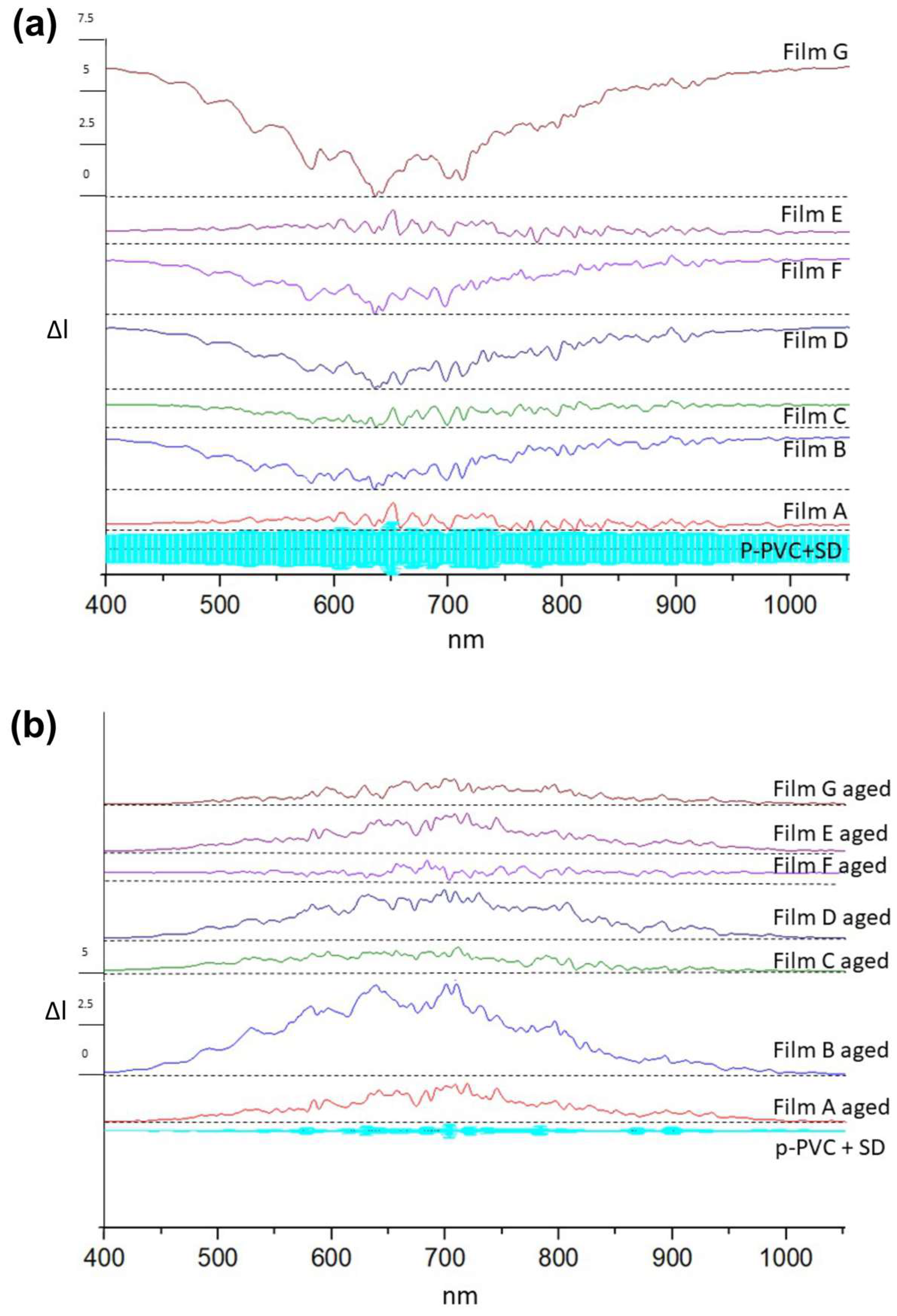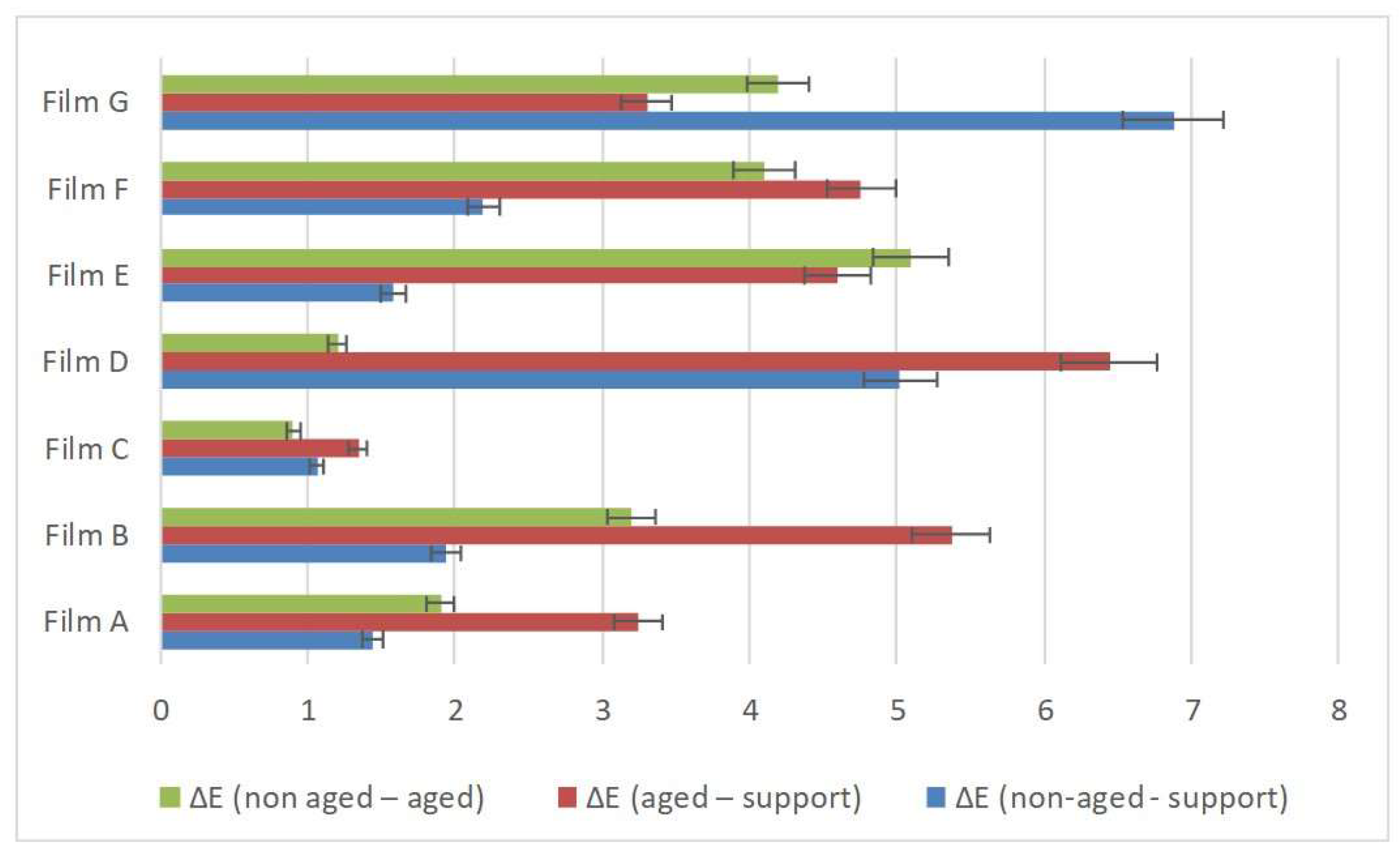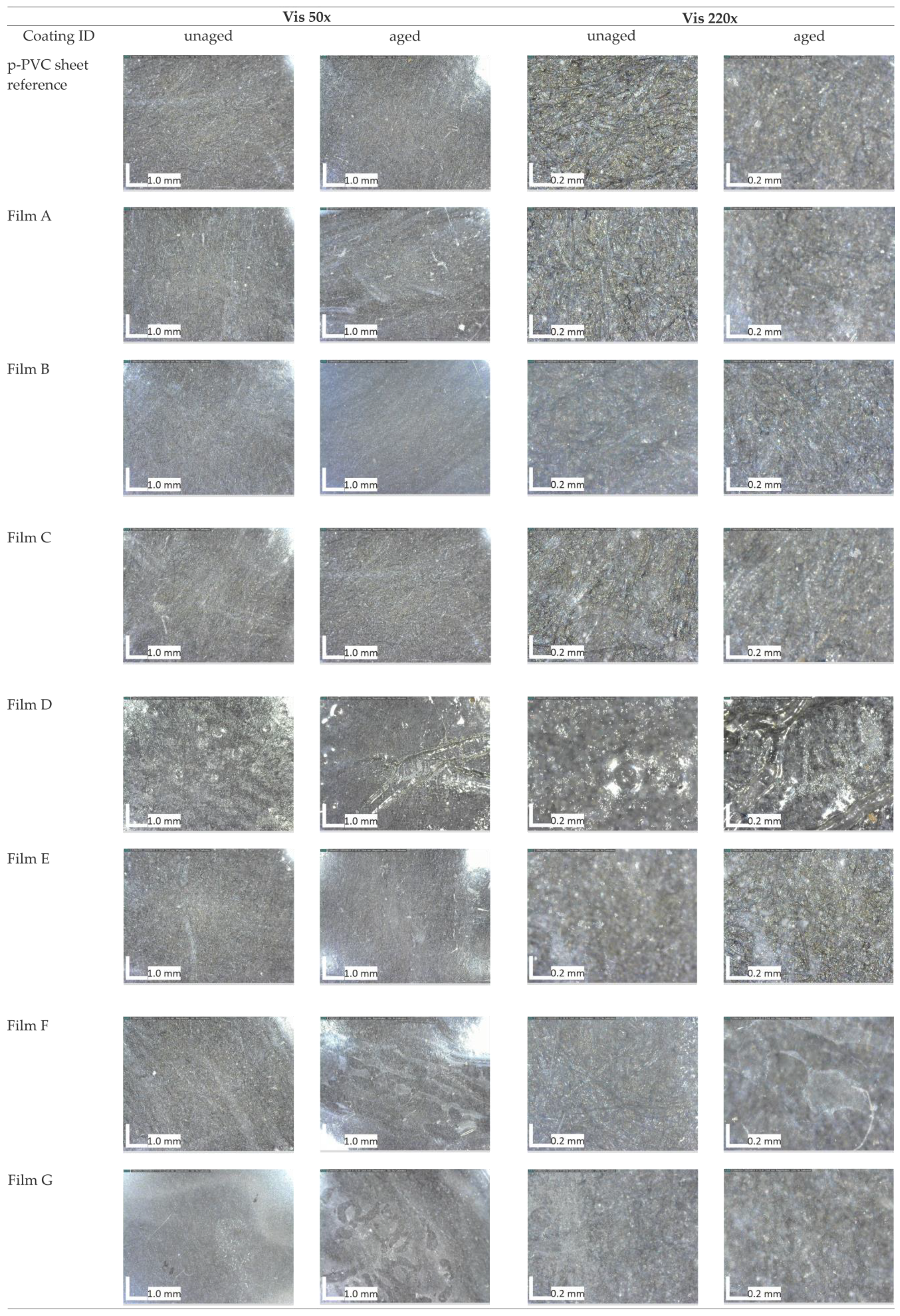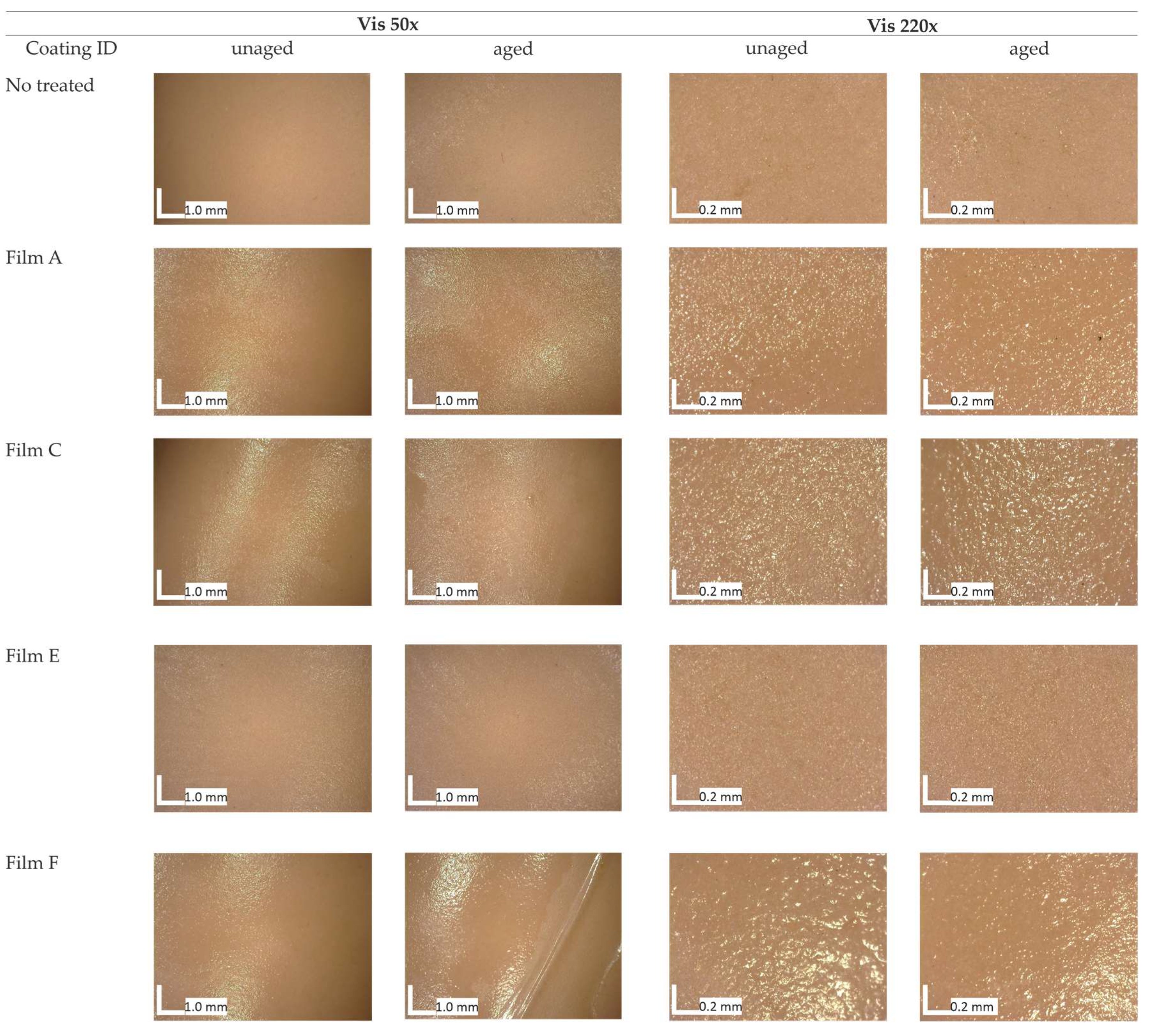Mattel’s ©Barbie: Preventing Plasticizers Leakage in PVC Artworks and Design Objects through Film-Forming Solutions
Abstract
:1. Introduction
2. Materials and Methods
2.1. Laboratory Specimen Tests
2.2. Application Test on a ©Barbie Doll as Case Study
2.3. Applicability Survey
3. Results
3.1. Test on Laboratory Specimens
3.2. Test on ©Barbie Doll
3.3. Survey
4. Discussion
5. Conclusions
Supplementary Materials
Author Contributions
Funding
Institutional Review Board Statement
Data Availability Statement
Acknowledgments
Conflicts of Interest
References
- Paulsen, F.L.; Nielsen, M.B.; Shashoua, Y.; Syberg, K.; Hansen, S.F. Early warning signs applied to plastic. Nat. Rev. Mater. 2022, 7, 68–70. [Google Scholar] [CrossRef]
- Conservation of Plastics. 2014. [Online]. Available online: www.getty.edu/conservation (accessed on 10 September 2023).
- Macchia, A.; Biribicchi, C.; Zaratti, C.; Testa Chiari, K.; D’Ambrosio, M.; Toscano, D.; Izzo, F.C.; La Russa, M.F. Mattel’s Barbie: Investigation of a Symbol—Analysis of Polymeric Matrices and Degradation Phenomena for Sixteen Dolls from 1959 to 1976. Polymers 2022, 14, 4287. [Google Scholar] [CrossRef] [PubMed]
- Babich, M.A.; Bevington, C.; Dreyfus, M.A. Plasticizer migration from children’s toys, child care articles, art materials, and school supplies. Regul. Toxicol. Pharmacol. 2020, 111, 104574. [Google Scholar] [CrossRef] [PubMed]
- Chen, Y.; Zhou, S.; Pan, S.; Zhao, D.; Wei, J.; Zhao, M.; Fan, H. Methods for determination of plasticizer migration from polyvinyl chloride synthetic materials: A mini review. J. Leather Sci. Eng. 2022, 4, 8. [Google Scholar] [CrossRef]
- Duran, A.; Kahve, H.I. The effect of chitosan coating and vacuum packaging on the microbiological and chemical properties of beef. Meat Sci. 2020, 162, 107961. [Google Scholar] [CrossRef] [PubMed]
- Flórez, M.; Guerra-Rodríguez, E.; Cazón, P.; Vázquez, M. Chitosan for food packaging: Recent advances in active and intelligent films. Food Hydrocoll. 2022, 124, 107328. [Google Scholar] [CrossRef]
- Andonegi, M.; Heras, K.L.; Santos-Vizcaíno, E.; Igartua, M.; Hernandez, R.M.; de la Caba, K.; Guerrero, P. Structure-properties relationship of chitosan/collagen films with potential for biomedical applications. Carbohydr. Polym. 2020, 237, 116159. [Google Scholar] [CrossRef]
- Wang, W.; Meng, Q.; Li, Q.; Liu, J.; Zhou, M.; Jin, Z.; Zhao, K. Chitosan derivatives and their application in biomedicine. Int. J. Mol. Sci. 2020, 21, 487. [Google Scholar] [CrossRef] [PubMed]
- Zhgun, A.; Avdanina, D.; Shagdarova, B.; Nuraeva, G.; Shumikhin, K.; Zhuikova, Y.; Il’ina, A.; Troyan, E.; Shitov, M.; Varlamov, V. The Application of Chitosan for Protection of Cultural Heritage Objects of the 15–16th Centuries in the State Tretyakov Gallery. Materials 2022, 15, 7773. [Google Scholar] [CrossRef] [PubMed]
- Ke, C.L.; Deng, F.S.; Chuang, C.Y.; Lin, C.H. Antimicrobial actions and applications of Chitosan. Polymers 2021, 13, 904. [Google Scholar] [CrossRef]
- Jiang, A.; Patel, R.; Padhan, B.; Palimkar, S.; Galgali, P.; Adhikari, A.; Varga, I.; Patel, M. Chitosan Based Biodegradable Composite for Antibacterial Food Packaging Application. Polymers 2023, 15, 2235. [Google Scholar] [CrossRef] [PubMed]
- Souza, V.G.L.; Pires, J.R.A.; Rodrigues, C.; Coelhoso, I.M.; Fernando, A.L. Chitosan composites in packaging industry-current trends and future challenges. Polymers 2020, 12, 417. [Google Scholar] [CrossRef] [PubMed]
- Escárcega-Galaz, A.A.; Sánchez-Machado, D.I.; López-Cervantes, J.; Sanches-Silva, A.; Madera-Santana, T.J.; Mechanical, P.P.-L. Structural and physical aspects of chitosan-based films as antimicrobial dressings. Int. J. Biol. Macromol. 2018, 116, 472–481. [Google Scholar] [CrossRef] [PubMed]
- Wang, X.; Hu, Y.; Zhang, Z.; Zhang, B. The application of thymol-loaded chitosan nanoparticles to control the biodeterioration of cultural heritage sites. J. Cult. Herit. 2022, 53, 206–211. [Google Scholar] [CrossRef]
- Boccaccini, F.; Giuliani, C.; Pascucci, M.; Riccucci, C.; Messina, E.; Staccioli, M.P.; Ingo, G.M.; Di Carlo, G. Toward a Green and Sustainable Silver Conservation: Development and Validation of Chitosan-Based Protective Coatings. Int. J. Mol. Sci. 2022, 23, 14454. [Google Scholar] [CrossRef] [PubMed]
- Tian, X.; Zhao, K.X.; Teng, A.; Li, Y.; Wang, W. A rethinking of collagen as tough biomaterials in meat packaging: Assembly from native to synthetic. Crit. Rev. Food Sci. Nutr. 2022, 64, 957–977. [Google Scholar] [CrossRef]
- Yang, H.; Guo, X.; Chen, X.; Shu, Z. Preparation and characterization of collagen food packaging film. J. Chem. Pharm. Res. 2014, 6, 740–745. [Google Scholar]
- Ahmad, M.; Nirmal, N.P.; Danish, M.; Chuprom, J.; Jafarzedeh, S. Characterisation of composite films fabricated from collagen/chitosan and collagen/soy protein isolate for food packaging applications. RSC Adv. 2016, 6, 82191–82204. [Google Scholar] [CrossRef]
- Bhadra, B.; Sakpal, A.; Patil, S.; Patil, S.; Date, A.; Prasad, V.; Dasgupta, S. A Guide to Collagen Sources, Applications and Current Advancements. Syst. Biosci. Eng. 2021, 1, 67–87. [Google Scholar] [CrossRef]
- Kozlowska, J.; Sionkowska, A.; Skopinska-Wisniewska, J.; Piechowicz, K. Characterization and potential application. Int. J. Biol. Macromol. 2015, 81, 220–227. [Google Scholar] [CrossRef]
- Kirby, D.P.; Buckley, M.; Promise, E.; Trauger, S.A.; Holdcraft, T.R. Identification of collagen-based materials in cultural heritage. Analyst 2013, 138, 4849. [Google Scholar] [CrossRef] [PubMed]
- Li, D.; Xu, F. Conservation of Tortoise Shell Using Hydroxyapatite/Collagen as a Consolidation Material. Stud. Conserv. 2022, 68, 318–325. [Google Scholar] [CrossRef]
- Stillger, L.; Müller, D. Peptide-coating combating antimicrobial contaminations: A review of covalent immobilization strategies for industrial applications. J. Mater. Sci. 2022, 57, 10863–10885. [Google Scholar] [CrossRef]
- Zhang, Y.; Chen, Z.; Liu, X.; Shi, J.; Chen, H.; Gong, Y. SEM, FTIR and DSC Investigation of Collagen Hydrolysate Treated Degraded Leather. J. Cult. Herit. 2021, 48, 205–210. [Google Scholar] [CrossRef]
- Yu, J.; Xu, S.; Goksen, G.; Yi, C.; Shao, P. Chitosan films plasticized with choline-based deep eutectic solvents: UV shielding, antioxidant, and antibacterial properties. Food Hydrocoll. 2023, 135, 108196. [Google Scholar] [CrossRef]
- Barbut, S.; Ioi, M. An investigation of the mechanical, microstructural and thermo-mechanical properties of collagen films cross-linked with smoke condensate and glutaraldehyde. Ital. J. Food Sci. 2019, 31, 644. [Google Scholar]
- Ding, C.; Zhang, M.; Li, G. Fluorescence study on the aggregation of collagen molecules in acid solution influenced by hydroxypropyl methylcellulose. Carbohydr. Polym. 2016, 136, 224–231. [Google Scholar] [CrossRef]
- Sobanwa, M.; Foster, T.J.; Yakubov, G.; Watson, N.J. How hydrocolloids can control the viscoelastic properties of acid-swollen collagen pastes. Food Hydrocoll. 2022, 126, 107486. [Google Scholar] [CrossRef]
- Zhang, T.; Yu, Z.; Ma, Y.; Chiou, B.S.; Liu, F.; Zhong, F. Modulating physicochemical properties of collagen films by cross-linking with glutaraldehyde at varied pH values. Food Hydrocoll. 2022, 124, 107270. [Google Scholar] [CrossRef]
- Ma, Y.; Ma, Y.; Yu, Z.; Chiou, B.-S.; Liu, F.; Zhong, F. Calcium spraying for fabricating collagen-alginate composite films with excellent wet mechanical properties. Food Hydrocoll. 2022, 124, 107340. [Google Scholar] [CrossRef]
- Giuliani, C.; Pascucci, M.; Riccucci, C.; Messina, E.; de Luna, M.S.; Lavorgna, M.; Ingo, G.M.; Di Carlo, G. Chitosan-based coatings for corrosion protection of copper-based alloys: A promising more sustainable approach for cultural heritage applications. Prog. Org. Coat. 2018, 122, 138–146. [Google Scholar] [CrossRef]
- Sangsuwan, J.; Rattanapanone, N.; Rachtanapun, P. Effect of chitosan/methyl cellulose films on microbial and quality characteristics of fresh-cut cantaloupe and pineapple. Postharvest Biol. Technol. 2008, 49, 403–410. [Google Scholar] [CrossRef]
- Möller, H.; Grelier, S.; Pardon, P.; Coma, V. Antimicrobial and physicochemical properties of chitosan—HPMC-based films. J. Agric. Food Chem. 2004, 52, 6585–6591. [Google Scholar] [CrossRef] [PubMed]
- Ding, C.; Zhang, M.; Li, G. Preparation and characterization of collagen/hydroxypropyl methylcellulose (HPMC) blend film. Carbohydr. Polym. 2015, 119, 194–201. [Google Scholar] [CrossRef] [PubMed]
- de Paiva, M.B.; Brasil, G.S.P.; Chagas, A.L.D.; Macedo, A.P.; Ramos, J.; Issa, J.P.M.; Gangrade, A.; Floriano, J.F.; Caetano, G.F.; Li, B.; et al. Latex–collagen membrane: An alternative treatment for tibial bone defects. J. Mater. Sci. 2022, 57, 22019–22041. [Google Scholar] [CrossRef]
- Santonicola, S.; Ibarra, V.G.; Sendón, R.; Mercogliano, R.; de Quirós, A.R.B. Antimicrobial films based on chitosan and methylcellulose containing natamycin for active packaging applications. Coatings 2017, 7, 177. [Google Scholar] [CrossRef]
- Royaux, A.; Fabre-Francke, I.; Balcar, N.; Barabant, G.; Bollard, C.; Lavédrine, B.; Cantin, S. Aging of plasticized polyvinyl chloride in heritage collections: The impact of conditioning and cleaning treatments. Polym. Degrad. Stab. 2017, 137, 109–121. [Google Scholar] [CrossRef]
- Popescu, C.; Budrugeac, P.; Wortmann, F.-J.; Miu, L.; Demco, D.E.; Baias, M. Assessment of collagen-based materials which are supports of cultural and historical objects. Polym. Degrad. Stab. 2008, 93, 976–982. [Google Scholar] [CrossRef]
- Klempová, S.; Oravec, M.; Vizárová, K. Analysis of thermally and UV–Vis aged plasticized PVC using UV–Vis, ATR-FTIR and Raman spectroscopy. Spectrochim. Acta A Mol. Biomol. Spectrosc. 2023, 294, 122541. [Google Scholar] [CrossRef]
- Shi, D.; Liu, F.; Yu, Z.; Chang, B.; Goff, H.D.; Zhong, F. Effect of aging treatment on the physicochemical properties of collagen films. Food Hydrocoll. 2019, 87, 436–447. [Google Scholar] [CrossRef]
- Vorobyova, M.; Biffoli, F.; Giurlani, W.; Martinuzzi, S.M.; Linser, M.; Caneschi, A.; Innocenti, M. PVD for Decorative Applications: A Review. Materials 2023, 16, 4919. [Google Scholar] [CrossRef] [PubMed]
- Mahy, M.; Van Eycken, L.; Oosterlinck, A. Evaluation of Uniform Color Spaces Developed after the Adoption of CIELAB and CIELUV. Color. Res. Appl. 1994, 19, 105–121. [Google Scholar] [CrossRef]
- Klinke, T.U.; Hannak, W.B.; Böning, K.; Jakstat, H.A.; Prause, E. Visual Tooth Color Determination with Different Reference Scales as an Exercise in Dental Students’ Education. Dent. J. 2023, 11, 275. [Google Scholar] [CrossRef] [PubMed]
- Giraud, T.; Gomez, A.; Lemoine, S.; Pelé-Meziani, C.; Raimon, A.; Guilminot, E. Use of gels for the cleaning of archaeological metals. Case study of silver-plated copper alloy coins. J. Cult. Herit. 2021, 52, 73–83. [Google Scholar] [CrossRef]
- Adamopoulos, F.G.; Vouvoudi, E.C.; Pavlidou, E.; Achilias, D.S.; Karapanagiotis, I. TEOS-Based Superhydrophobic Coating for the Protection of Stone-Built Cultural Heritage. Coatings 2021, 11, 135. [Google Scholar] [CrossRef]
- Cappitelli, F.; Villa, F.; Sanmartín, P. Interactions of microorganisms and synthetic polymers in cultural heritage conservation. Int. Biodeterior. Biodegrad. 2021, 163, 105282. [Google Scholar] [CrossRef]
- Cerchiara, T.; Palermo, A.M.; Esposito, G.; Chidichimo, G. Effects of microwave heating for the conservation of paper artworks contaminated with Aspergillus versicolor. Cellulose 2018, 25, 2063–2074. [Google Scholar] [CrossRef]
- Sterflinger, K.; Piñar, G. Molecular-Based Techniques for the Study of Microbial Communities in Artworks. In Microorganisms in the Deterioration and Preservation of Cultural Heritage; Springer International Publishing: Cham, Switzerland, 2021; pp. 59–77. [Google Scholar] [CrossRef]
- de Carvalho, H.P.; Mesquita, N.; Trovão, J.; Rodríguez, S.F.; Pinheiro, A.C.; Gomes, V.; Alcoforado, A.; Gil, F.; Portugal, A. Fungal contamination of paintings and wooden sculptures inside the storage room of a museum: Are current norms and reference values adequate? J. Cult. Herit. 2018, 34, 268–276. [Google Scholar] [CrossRef]
- ASTM D1434-82; Standard Test Method for Determining Gas Permeability Characteristics of Plastic Film and Sheeting. American Society Testing Materials: West Conshohocken, PA, USA, 2015.
- Balcar, N.; Barabant, G.; Bollard, C.; Keneghan, B.; Kulperholc, S.; Lagana, A.; van Oosten, T.; Segel, K.; Shashoua, Y. Studies in cleaning plastics. In POPART: Preservation of Plastic ARTefacts in Museum Collections; CTHS Edition: Paris, France, 2012. [Google Scholar]
- Macchia, A.; Zaratti, C.; Biribicchi, C.; Colasanti, I.A.; Barbaccia, F.I.; Favero, G. Evaluation of Green Solvents’ Applicability for Chromatic Reintegration of Polychrome Artworks. Heritage 2023, 6, 3353–3364. [Google Scholar] [CrossRef]
- Wang, L.; Chen, C.; Wang, J.; Gardner, D.J.; Tajvidi, M. Cellulose nanofibrils versus cellulose nanocrystals: Comparison of performance in flexible multilayer films for packaging applications. Food Packag. Shelf Life 2020, 23, 100464. [Google Scholar] [CrossRef]
- Rahman, M.U.; Li, J. Influence of Waste Filler on the Mechanical Properties and Microstructure of Epoxy Mortar. Appl. Sci. 2023, 13, 6857. [Google Scholar] [CrossRef]
- Matsuzawa, Y.; Ayabe, M.; Nishino, J. Acceleration of cellulose co-pyrolysis with polymer. Polym. Degrad. Stab. 2001, 71, 435–444. [Google Scholar] [CrossRef]
- Zhou, J.; Liu, G.; Wang, S.; Zhang, H.; Xu, F. TG-FTIR and Py-GC/MS study of the pyrolysis mechanism and composition of volatiles from flash pyrolysis of PVC. J. Energy Inst. 2020, 93, 2362–2370. [Google Scholar] [CrossRef]
- Xu, Z.; Ierulli, V.; Bar-Ziv, E.; McDonald, A. Thermal Degradation and Organic Chlorine Removal from Mixed Plastic Wastes. Energies 2022, 15, 6058. [Google Scholar] [CrossRef]
- Yang, S.; Wang, Y.; Man, P. Kinetic Analysis of Thermal Decomposition of Polyvinyl Chloride at Various Oxygen Concentrations. Fire 2023, 6, 404. [Google Scholar] [CrossRef]
- Hu, D.; Wang, H.; Wang, L. Physical properties and antibacterial activity of quaternized chitosan/carboxymethyl cellulose blend films. LWT Food Sci. Technol. 2016, 65, 398–405. [Google Scholar] [CrossRef]
- Barbosa, H.F.G.; Francisco, D.S.; Ferreira, A.P.G.; Cavalheiro, É.T.G. A new look towards the thermal decomposition of chitins and chitosans with different degrees of deacetylation by coupled TG-FTIR. Carbohydr. Polym. 2019, 225, 115232. [Google Scholar] [CrossRef] [PubMed]
- Mauricio-Sánchez, R.A.; Salazar, R.; Luna-Bárcenas, J.G.; Mendoza-Galván, A. FTIR spectroscopy studies on the spontaneous neutralization of chitosan acetate films by moisture conditioning. Vib. Spectrosc. 2018, 94, 1–6. [Google Scholar] [CrossRef]
- Grgac, S.F.; Biruš, T.-D.; Tarbuk, A.; Dekanić, T.; Palčić, A. The Durable Chitosan Functionalization of Cellulosic Fabrics. Polymers 2023, 15, 3829. [Google Scholar] [CrossRef]
- Carvalho, J.D.D.S.; Rabelo, R.S.; Hubinger, M.D. Thermo-rheological properties of chitosan hydrogels with hydroxypropyl methylcellulose and methylcellulose. Int. J. Biol. Macromol. 2022, 209, 367–375. [Google Scholar] [CrossRef]
- Cichosz, S.; Masek, A. IR Study on Cellulose with the Varied Moisture Contents: Insight into the Supramolecular Structure. Materials 2020, 13, 4573. [Google Scholar] [CrossRef] [PubMed]
- Kitsara, M.; Tassis, G.; Papagiannopoulos, A.; Simon, A.; Agbulut, O.; Pispas, S. Polysaccharide–Protein Multilayers Based on Chitosan–Fibrinogen Assemblies for Cardiac Cell Engineering. Macromol. Biosci. 2021, 22, 2100346. [Google Scholar] [CrossRef]
- Herzog, M.; Tiso, T.; Blank, L.M.; Winter, R. Interaction of rhamnolipids with model biomembranes of varying complexity. Biochim. Biophys. Acta (BBA)—Biomembr. 2020, 1862, 183431. [Google Scholar] [CrossRef] [PubMed]
- Bussiere, O.; Gardette, J.-L.; Rapp, G.; Masson, C.; Therias, S.; Bussière, P.-O. New insights into the mechanism of photodegradation of chitosan New insights into the mechanism of photodegradation of chitosan 1. Carbohydr. Polym. 2021, 259, 117715. [Google Scholar] [CrossRef]
- Bhuimbar, M.V.; Bhagwat, P.K.; Dandge, P.B. Extraction and characterization of acid soluble collagen from fish waste: Development of collagen-chitosan blend as food packaging film. J. Environ. Chem. Eng. 2019, 7, 102983. [Google Scholar] [CrossRef]
- Stani, C.; Vaccari, L.; Mitri, E.; Birarda, G. FTIR investigation of the secondary structure of type I collagen: New insight into the amide III band. Spectrochim. Acta A Mol. Biomol. Spectrosc. 2020, 229, 118006. [Google Scholar] [CrossRef]
- Popescu, M.-C.; Froidevaux, J.; Navi, P.; Popescu, C.-M. Structural modifications of Tilia cordata wood during heat treatment investigated by FT-IR and 2D IR correlation spectroscopy. J. Mol. Struct. 2013, 1033, 176–186. [Google Scholar] [CrossRef]
- Sukthawon, C.; Dittanet, P.; Saeoui, P.; Loykulnant, S.; Prapainainar, P. Electron beam irradiation crosslinked chitosan/natural rubber -latex film: Preparation and characterization. Radiat. Phys. Chem. 2020, 177, 109159. [Google Scholar] [CrossRef]
- Wang, W.; Zhang, Y.; Zhang, Y.; Vulcanization, J.S. static mechanical properties, and thermal stability of activated calcium silicate/styrene-butadiene rubber composites prepared via a latex compounding method. J. Appl. Polym. Sci. 2022, 139. [Google Scholar] [CrossRef]
- Yamamoto, Y.; Norulhuda, S.N.B.; Nghia, P.T.; Kawahara, S. Thermal degradation of deproteinized natural rubber. Polym. Degrad. Stab. 2018, 156, 144–150. [Google Scholar] [CrossRef]
- Buraidah, M.H.; Arof, A.K. Characterization of chitosan/PVA blended electrolyte doped with NH4I. J. Non-Cryst. Solids 2011, 357, 3261–3266. [Google Scholar] [CrossRef]
- Ngwa, W.; Wannemacher, R.; Grill, W.; Serghei, A.; Kremer, F.; Kundu, T. Voronoi Tessellations in Thin Polymer Blend Films. Macromolecules 2004, 37, 1691–1692. [Google Scholar] [CrossRef]
- Janiszewska, N.; Raczkowska, J.; Budkowski, A.; Gajos, K.; Stetsyshyn, Y.; Michalik, M.; Awsiuk, K. Dewetting of Polymer Films Controlled by Protein Adsorption. Langmuir 2020, 36, 11817–11828. [Google Scholar] [CrossRef]
- Wang, C.; Krausch, G.; Geoghegan, M. Dewetting at a Polymer−Polymer Interface: Film Thickness Dependence. Langmuir 2001, 17, 6269–6274. [Google Scholar] [CrossRef]






| Coating ID | Composition | Preparation | References |
|---|---|---|---|
| Film A | Chitosan + Methylcellulose | 1.5 g chitosan in 100 mL of 1% acetic acid aqueous solution. To adjust the pH value into more neutral conditions, 1 M NaOH was added until pH 6.2 was obtained. 1.5 g methylcellulose dissolved in 50 mL of 50% ethanol solution. Chitosan and methylcellulose were mixed under stirring. | [32,33] |
| Film B | Chitosan + Hydroxypropyl Methylcellulose | Composite coating is prepared from chitosan-HPMC 50:50 proportionally. Chitosan is dissolved in 1% acetic acid aqueous solution to prepare a 2% w/v chitosan aqueous solution. 9 parts of HPMC are dissolved in distilled water (200 parts) and ethanol (100 parts). | [34] |
| Film C | Collagen + Methylcellulose | 15 mg/mL collagen is dissolved in 0.1 mol/mL acetic acid aqueous solution and then added 15 mg/mL HPMC solubilized in 50:50 water ethanol solution | [35] |
| Film D | Collagen + Natural rubber | 7.5 g of collagen powder is solubilized in 50 mL distilled water and then added 0.04 mL of natural rubber ready to use. | [36] |
| Film E | Methylcellulose | Methylcellulose 3% w/v is mixed with water-ethanol solution 50:50 v/v. | [37] |
| Film F | Chitosan | 1.5 g chitosan in 100 mL 1% acetic acid aqueous solution chitosan w/v in 1% acid acetic + 0.2 g glycerol | [37] |
| Film G | Hydroxyethyl Cellulose (HEC) | HPMC is dissolved in solution water-ethanol as in preparation of Film C | [34] |
| Part 1—Analysis of the coating before the application | ||
Appearance:
| Consistency:
| |
| Part 2—Analysis of the coating during the application | ||
Appearance:
| Consistency:
| Separation tendency of the Coating into different phases:
|
Application on the surface:
| Texture:
| |
| Part 3—Evaluation after the formation of the coating | ||
Appearance:
| Drying rate:
| Touch sensation:
|
| Part 4—Coating removal | ||
Mechanical action:
| Solvent action: 1. Deionized water
| 2. Ethanol
|
Coating surface wettability:
| Removal rate:
| Need to apply poultice to speed up the removal:
|
Effects of removal on the surface:
| ||
| Unaged | Aged | |||
|---|---|---|---|---|
| ID Sample | Wavenumber (cm−1) | Molecular Bond | Wavenumber (cm−1) | Molecular Bond |
| PVC substrate | 1718 1405 1238 1116, 1088, 1018 950 852, 660 | C=O ester CH2 bending C-H rocking C-O and C-O-H C-H aromatic vibration C-Cl stretching | ||
| Film A | 3362 1582, 1426 1374, 1320 1156, 1075, 1033, 956 | O-H stretch C=O asymmetric and symmetric vibration CH3 symmetric angular deformation C-O-C bond stretching | 3328 1718 1582, 1425 1075, 1034, 956 | O-H stretch C=O ester C=O CH3 |
| Film B | 3334 1372, 1315 1062, 1023, 948 | O-H stretch CN- stretching involving N from amino group III and CH2 vibration C-O-C | 1718 1278, 1248 1116, 1101 1018 950 | C=O ester C-H rocking bond C-O C-O-H C-H |
| Film C | 3277 1624, 1524, 1240 1445 1396, 1324, 1240 1058; 1032 | O-H stretch N-H bending and C-N stretching of amides II and III C-H bending OH vibration Amide III of type I collagen C-O-C and C-O | 3278 1624, 1524 1445 1396, 1324, 1240 1058; 1032 | O-H stretch N-H bending and C-N stretching of amides II and III C-H bending OH vibration Amide III of type I collagen C-O-C and C-O |
| Film D | 1660, 1630 1547 1447 2959, 2927, 2854 1447, 1375 1324, 1243 1063, 1017 | amide I associated with C=O N-H bending amide III of collagen C=C stretching C-H bending OH vibration C-O-C | 1718 1447, 1375 1266; 1249 1115, 1101, 1018 | C=O ester amide III of collagen C-O C-O-C |
| Film E | 3334 1320 1106, 1053, 1028, 947 | O-H stretch CH3 C-O-C | 3437 1718 1267, 1250 1106, 1059 | O-H stretch C=O ester C-H C-O-C |
| Film F | 3334 1652 1585 1374, 1328 1066, 1027, 987 | O-H stretch C-N N-H CN C-O | 3328 1652 1374, 1328 1066, 1027, 987 | O-H stretch C-N CN C-O |
| Film G | 3334 1099, 1051, 943 | O-H stretch C-O-C | 3362 1718 1267 1101 | O-H stretch C=O ester C-H C-O-C |
| OTR (cm3/m2) | SD | |
|---|---|---|
| Film A | 0.48 | 0.005 |
| Film B | 0.29 | 0.032 |
| Film C | 0.39 | 0.012 |
| Film D | 0.29 | 0.003 |
| Film E | 0.15 | 0.012 |
| Film F | 0.34 | 0.007 |
| Film G | 0.22 | 0.003 |
| Film A | Film B | Film C | Film D | Film E | Film F | Film G | ||
|---|---|---|---|---|---|---|---|---|
| Part 1 | Appearance | Transparent | Transparent | Transparent | Opaque / Mat | Transparent | Transparent | Transparent |
| Consistency | Viscous | Viscous | Fluid | Liquid | Viscous | Liquid | Viscous | |
| Part 2 | Appearance | Gloss | Gloss | Gloss | Opaque / Mat and Gloss | Gloss | Gloss | Gloss |
| Consistency | Viscous | Viscous | Fluid | Liquid | Viscous | Liquid | Viscous | |
| Separation tendency | Low | Low | Low | High | Low | Medium | Low | |
| Texture | Non-uniform | Non-uniform | Uniform | Non-uniform | Uniform | Uniform | Non-uniform | |
| Application | Medium | Medium | Easy | Difficult | Easy | Difficult | Easy | |
| Part 3 | Appearance | Transparent | Opaque / Mat | Transparent | Gloss | Transparent | Transparent | Transparent |
| Drying rate | Medium | High | High | Medium | Medium | High | High | |
| Touch sensation | Smooth | Smooth | Smooth | Gummy | Smooth | Smooth | Smooth | |
| Part 4 | Mechanical cleaning | Ineffective | Ineffective | Ineffective | Easy | Ineffective | Ineffective | Ineffective |
| Deionized water-based cleaning | Easy | Difficult | Difficult | Ineffective | Easy | Difficult | Difficult | |
| Ethanol -based cleaning | Easy | Easy | Easy | Difficult | Easy | Easy | Easy | |
| Wettability | Good | Medium | Medium | Bad | Good | Medium | Medium | |
| Removal rate | Fast | Medium | Slow | - | Fast | Medium | Medium | |
| Need poultice | No | No | No | No | No | No | No | |
| Effect on surface | None | None | None | None | None | None | None | |
Disclaimer/Publisher’s Note: The statements, opinions and data contained in all publications are solely those of the individual author(s) and contributor(s) and not of MDPI and/or the editor(s). MDPI and/or the editor(s) disclaim responsibility for any injury to people or property resulting from any ideas, methods, instructions or products referred to in the content. |
© 2024 by the authors. Licensee MDPI, Basel, Switzerland. This article is an open access article distributed under the terms and conditions of the Creative Commons Attribution (CC BY) license (https://creativecommons.org/licenses/by/4.0/).
Share and Cite
Macchia, A.; Marinelli, L.; Barbaccia, F.I.; de Caro, T.; Hansen, A.; Schuberthan, L.M.; Izzo, F.C.; Pintus, V.; Testa Chiari, K.; La Russa, M.F. Mattel’s ©Barbie: Preventing Plasticizers Leakage in PVC Artworks and Design Objects through Film-Forming Solutions. Polymers 2024, 16, 1888. https://doi.org/10.3390/polym16131888
Macchia A, Marinelli L, Barbaccia FI, de Caro T, Hansen A, Schuberthan LM, Izzo FC, Pintus V, Testa Chiari K, La Russa MF. Mattel’s ©Barbie: Preventing Plasticizers Leakage in PVC Artworks and Design Objects through Film-Forming Solutions. Polymers. 2024; 16(13):1888. https://doi.org/10.3390/polym16131888
Chicago/Turabian StyleMacchia, Andrea, Livia Marinelli, Francesca Irene Barbaccia, Tilde de Caro, Alice Hansen, Lisa Maria Schuberthan, Francesca Caterina Izzo, Valentina Pintus, Katiuscia Testa Chiari, and Mauro Francesco La Russa. 2024. "Mattel’s ©Barbie: Preventing Plasticizers Leakage in PVC Artworks and Design Objects through Film-Forming Solutions" Polymers 16, no. 13: 1888. https://doi.org/10.3390/polym16131888
APA StyleMacchia, A., Marinelli, L., Barbaccia, F. I., de Caro, T., Hansen, A., Schuberthan, L. M., Izzo, F. C., Pintus, V., Testa Chiari, K., & La Russa, M. F. (2024). Mattel’s ©Barbie: Preventing Plasticizers Leakage in PVC Artworks and Design Objects through Film-Forming Solutions. Polymers, 16(13), 1888. https://doi.org/10.3390/polym16131888










